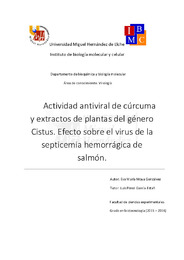Please use this identifier to cite or link to this item:
https://hdl.handle.net/11000/3519Full metadata record
| DC Field | Value | Language |
|---|---|---|
| dc.contributor.advisor | Pérez García-Estañ, Luis | - |
| dc.contributor.author | Moya Gonzálvez, Eva María | - |
| dc.date.accessioned | 2017-04-06T14:27:44Z | - |
| dc.date.available | 2017-04-06T14:27:44Z | - |
| dc.date.created | 2016-07-12 | - |
| dc.date.issued | 2017-04-06 | - |
| dc.identifier.uri | http://hdl.handle.net/11000/3519 | - |
| dc.description.abstract | Las enfermedades de origen viral suponen una seria amenaza para la Acuicultura, causando lamentables pérdidas económicas. Dos son las formas en las que se puede abordar este problema: la prevención (mediante vacunas) y la terapia. Las plantas llevan décadas siendo una fuente de fármacos con actividad antiviral. Este trabajo evalúa la actividad inhibitoria de compuestos de origen vegetal frente a un virus de gran importancia en el cultivo de trucha y salmón: el virus de la septicemia hemorrágica vírica (VHSV). Se probó el efecto de seis extractos de Cistus (denominados de E1 a E6), a ciegas, sobre la replicación del virus en una línea celular de carpa (EPC). Dos de los extractos (E2 y E5) muestran actividad inhibitoria frente a VHSV a una concentración de 20-40 μg/ml al añadirlos durante la infección. Se determinó también su actividad frente a otro virus de salmón (IPNV) y frente al virus de carpa SVCV.En base a estudios previos, en los que se ha demostrado la actividad anti-VHSV de la cúrcuma, se estudió su efecto utilizando tanto una preparación cruda como una filtrada. Los resultados muestran que la preparación cruda tiene capacidad de inhibir la replicación de VHSV, pero es poco homogénea y tiende a precipitar. La preparación filtrada, por el contrario, carece de actividad antiviral significativa. | es |
| dc.description.abstract | The diseases of viral origin pose a serious threat for the Fish farming, causing devastating economic losses. Two are the ways to approach this problem: prevention (by means of vaccines) and therapy. Plants have being for decades being a source of compounds with antiviral activity. This study evaluates the inhibitory activity of plant compounds against a great important virus in the culture of trout and salmon: Viral Hemorrhagic Septicemia Virus (VHSV). Here we tested the effect of six Cistus's extracts (named of E1 to E6), blindly, on the replication of the virus in a cellular line of carp (EPC). Two of the extracts (E2 and E5) show inhibitory activity against VHSV at concentrations of 20-40 μg/ml when we added them during the infection. E2 and E5 also seems to have activity against another virus of salmon (IPNV) and against a virus of tent (SVCV).In previous studies, the anti-VHSV activity of curcumin has been reported, also the effect on VHSV was studied using so much a raw preparation as a well as a filtered solution. The results show that the raw preparation can disable VHSV replication, but it is slightly homogeneous and tends to precipitate. The filtered preparation, on the contrary, has not significant activity. | es |
| dc.format | application/pdf | es |
| dc.format.extent | 44 | es |
| dc.language.iso | spa | es |
| dc.rights | info:eu-repo/semantics/openAccess | es |
| dc.subject | Acuicultura | es |
| dc.subject | Antivirales | es |
| dc.subject | fitoterapia | es |
| dc.subject.other | CDU::5 - Ciencias puras y naturales::57 - Biología::577 - Bioquímica. Biología molecular. Biofísica | es |
| dc.title | Actividad antiviral de cúrcuma y extractos de plantas del género Cistus. Efecto sobre el virus de la septicemia hemorrágica de salmón | es |
| dc.type | info:eu-repo/semantics/bachelorThesis | es |

View/Open:
Moya Gonzalvez, Eva María.pdf
2,13 MB
Adobe PDF
Share:
.png)
